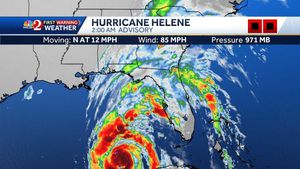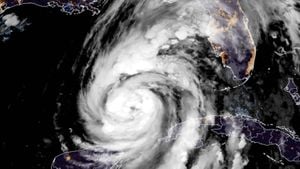In the 1980s, a mysterious and catastrophic event occurred in the waters of the Caribbean, decimating the populations of the sea urchin Diadema antillarum. These small, spiky creatures play a crucial role in maintaining the health of coral reefs, but within months, nearly 98% of their population vanished, causing a domino effect that reshaped the entire ecosystem. Fast forward to 2022, and a similar tragedy struck again, providing scientists with a rare second chance to solve this decades-old mystery. Researchers, led by Dr. Ian Hewson, have finally pinpointed the culprit: a single-celled protist known as a scuticociliate.
The findings, published by Hewson et al. in Science Advances, shed light on one of the most significant marine disease outbreaks ever recorded. The 2022 die-off mirrored the events of the 1980s so closely that it reignited scientific inquiry into what may have caused such widespread devastation. By employing a combination of traditional and modern scientific techniques, the research team was able to identify and confirm the pathogen responsible. This breakthrough has significant implications for marine ecology, disease management, and our understanding of how such diseases can ripple through an ecosystem.
Sea urchins like Diadema antillarum are essential gardeners of the reef. They graze on algae, preventing it from overgrowing and suffocating the corals. Coral reefs, in turn, provide habitat and protection for a myriad of marine species, and their structures buffer coastal areas against storms. The mass mortality of these urchins in the 1980s led to a proliferation of algae, which stifled coral growth and reduced the structural complexity of the reefs, causing a dramatic shift in the ecosystem. This phenomenon, observed vividly in the waters near Jamaica, was described as a transition from coral-dominated reefs to algal-dominated flats. Quentin Wheeler noted, "The loss of Diadema fundamentally altered the ecosystem to the detriment of coral reef health".
Understanding the historical context of these events is crucial. The 1983 die-off was sudden and unprecedented, occurring when marine scientists lacked the tools and knowledge to investigate effectively. It wasn't until the recent repeated event that scientists had the means to delve deeper. "The lack of preparedness and technological limitations in the 1980s meant that we missed our chance to understand the disease back then," said Hewson et al. in their paper. The 2022 outbreak, however, provided ample opportunity for modern investigative techniques.
Hewson and his team utilized several methods, both old and new, to uncover the mystery. They conducted culture-based work and histopathology, a technique that examines the microscopic structure of diseased tissue. They also leveraged high-throughput sequencing and quantitative PCR (qPCR) to scrutinize the genetic material within the affected urchins. By comparing specimens from various afflicted and unaffected sites, they identified DNA evidence pointing to the scuticociliate pathogen. This single-celled organism, they found, was present in diseased urchins but not in the healthy ones, ruling out other potential microbial culprits like bacteria or viruses.
One of the most compelling parts of their methodology was the use of molecular techniques to track the abundance of the ciliate. By growing cultures of the suspected pathogens and then exposing healthy urchins to them, the researchers were able to replicate the disease symptoms observed in the wild. This experimental approach confirmed that the scuticociliate was indeed the pathogen responsible for the die-offs. Such an innovative application of both classical and contemporary methods underscored the importance of multidisciplinary approaches in solving complex ecological problems.
These findings have profound implications. For one, they highlight the vulnerability of marine ecosystems to disease outbreaks and the cascading effects these can have. The 1980s Diadema die-off demonstrated how the loss of a single species could lead to significant ecological shifts. In this case, the decline of urchin populations led to algae overgrowth, coral reef degradation, and a loss of biodiversity. Similar patterns were observed during the recent outbreak, with community-wide and even ecosystem-wide impacts. As noted in the publication, "Mass mortality events can fundamentally alter entire ecosystems".
The broader significance of this study also extends to marine disease management. It underscores the need for continuous and robust marine disease surveillance. While significant strides have been made, such as NOAA's early detection programs for various marine diseases, much work remains. Improved diagnostic tools and international cooperation are vital. Dr. Hewson emphasized, "We need additional and continuous support for marine disease surveillance and forecasting programs to better understand and mitigate outbreaks in the future".
Exploring the broader implications, the study's findings could spur changes in policy and industry practices. For policymakers, the vulnerability of marine ecosystems to disease outbreaks highlights the need for stronger environmental protections and investments in marine science. Industry professionals, particularly those in fisheries and tourism, may need to adapt practices to safeguard these environments better. The general public, especially those in coastal communities, benefits indirectly from healthy coral reefs, which protect shorelines and support local economies.
But beyond these practical considerations, the research also opens the door to new scientific questions. For instance, why are scuticociliates, generally known to coexist benignly with marine life, causing such deadly outbreaks now? This question touches upon broader themes in marine biology, such as environmental stressors like climate change, pollution, and human interference that may be exacerbating the virulence or spread of pathogens. Further research could explore these dimensions, providing deeper insights into marine disease ecology and the interplay between different environmental factors.
However, the study is not without its limitations. While the use of advanced molecular techniques provided strong evidence implicating the scuticociliate, the vast and dynamic nature of marine environments poses ongoing challenges. Data collection in such settings is inherently tricky, with variables that are hard to control. Moreover, the study's observational nature means that while correlations are robust, establishing causation beyond doubt remains complex. Future research could focus on more extensive sampling and longitudinal studies to build on these findings.
Looking ahead, the study by Hewson et al. sets the stage for a new era in marine disease research. It calls for interdisciplinary approaches that combine the strengths of traditional marine biology with the innovations of modern molecular biology and environmental science. Such collaboration could lead to the development of predictive models and early warning systems, akin to meteorological forecasting, to predict and mitigate disease outbreaks in marine ecosystems.
In conclusion, the story of the Diadema antillarum die-offs acts as both a cautionary tale and a beacon of hope. It illustrates the fragility of marine ecosystems and the intricate connections that bind their inhabitants. At the same time, it showcases the power of modern science to solve long-standing ecological mysteries. As Hewson eloquently puts it, "With international cooperation and financing to track emerging infectious diseases in the sea, we can be more prepared and potentially able to understand and hopefully mitigate marine disease outbreaks in the future".



